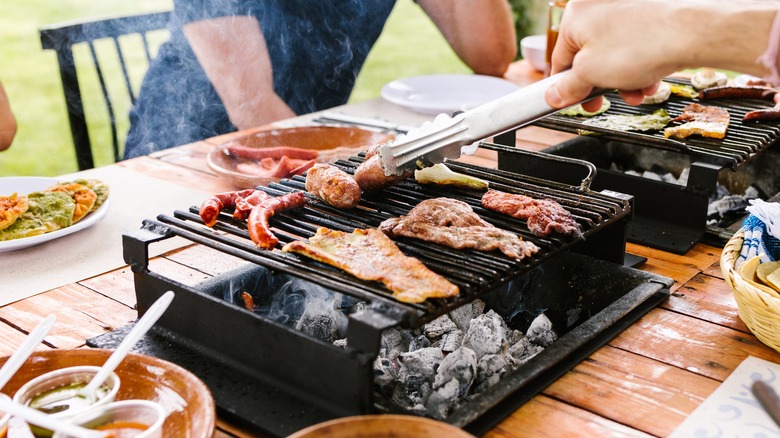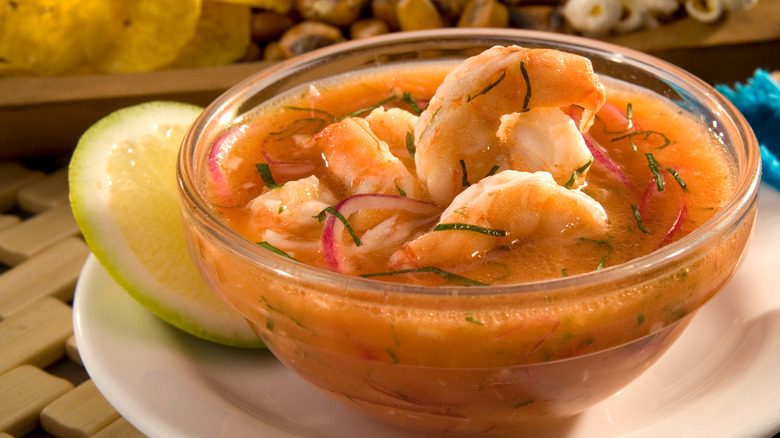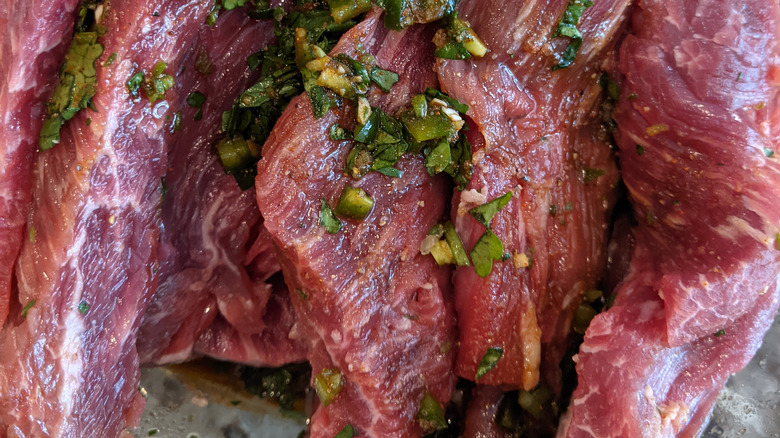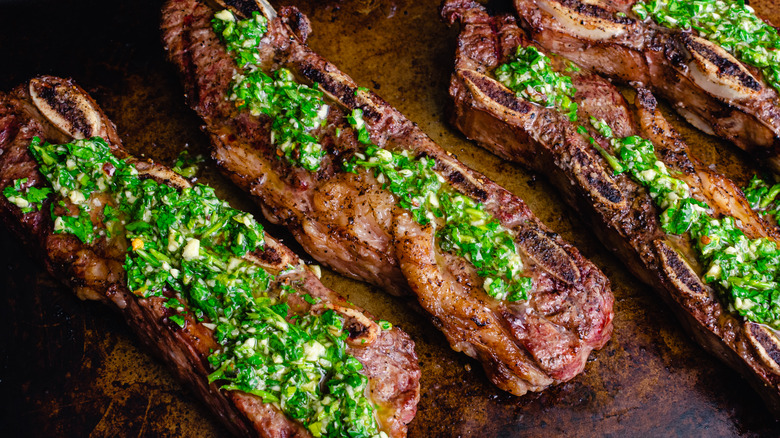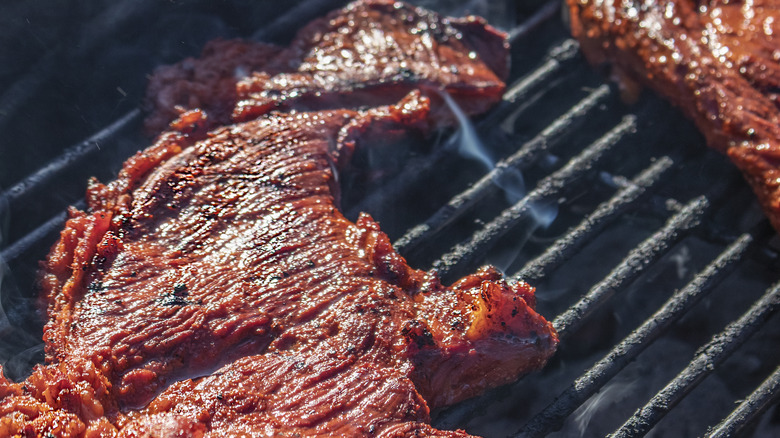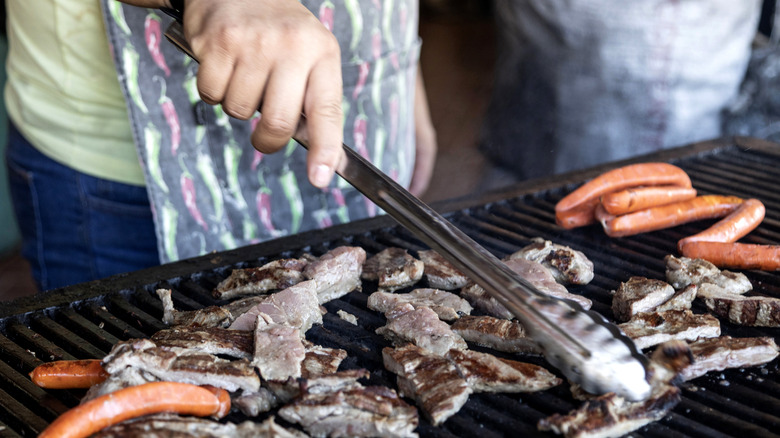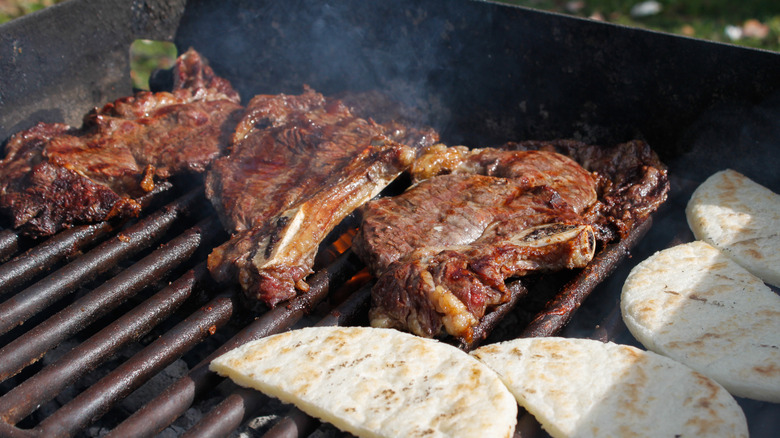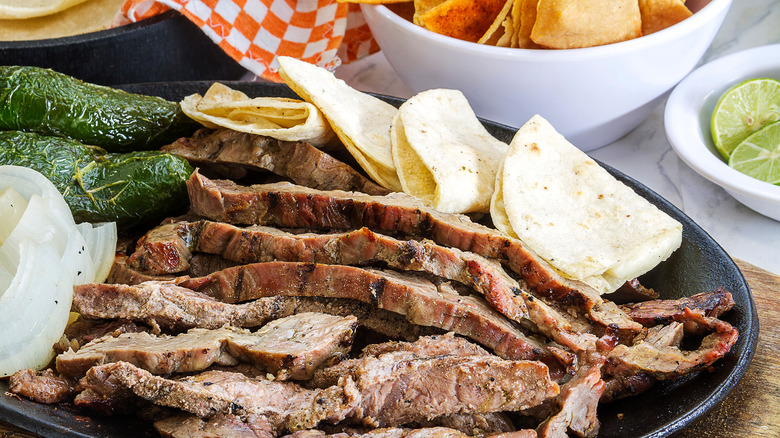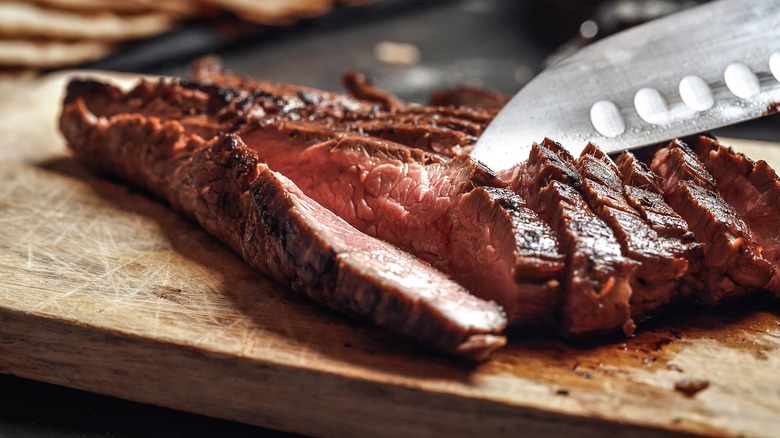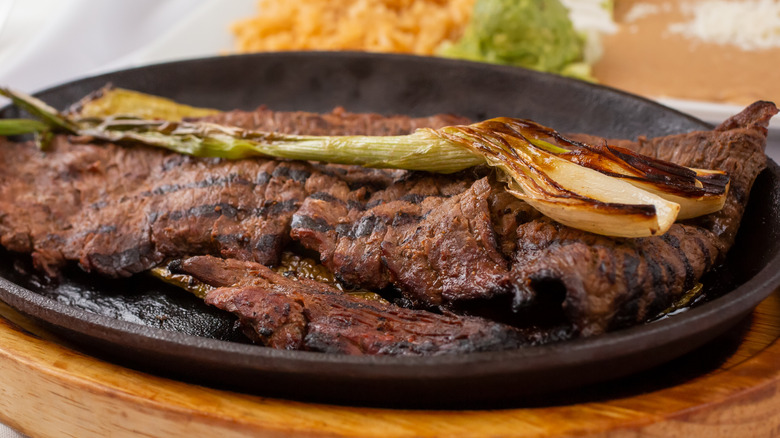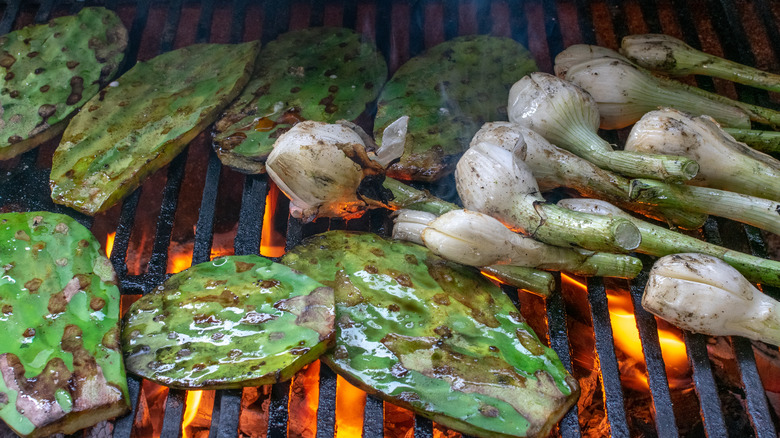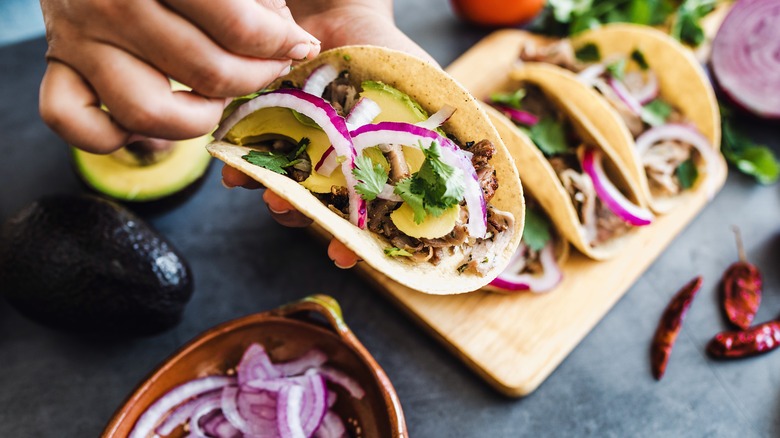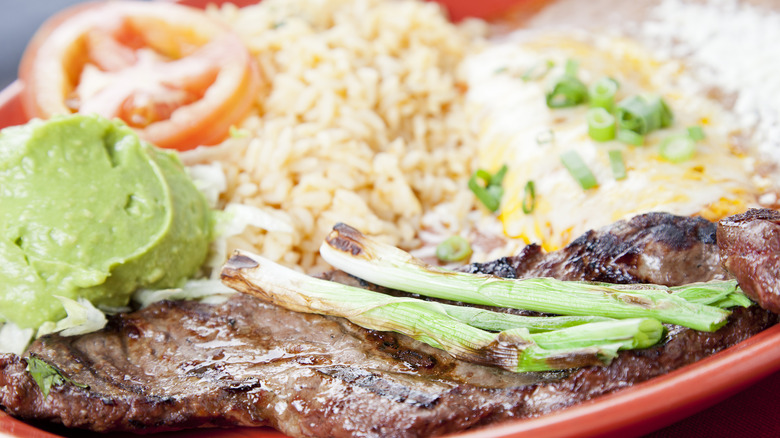12 Ultimate Tips For Preparing Carne Asada, According To Chef Bricia Lopez - Exclusive
We see you, fam, looking for an exceptional carne asada recipe, scouring the internet for tips, tricks, and hacks ahead of an upcoming backyard asada adventure. Stop biting your nails. You've found the perfect starting point. Tasting Table talked to Mexican-American chef Bricia Lopez to walk you through asada basics. Lopez, co-owner of the L.A.-based James-Beard Award-winning, Oaxcana restaurant Guelaguetza recently released "Asada: The Art Of Mexican-Style Grilling." This — the chef announced on her socials — is the first book to detail Mexican grilling techniques ever. Let's pause for a moment of hungry and appreciative silence.
In it, you'll find the obvious: carne asada marinades, meat guides, and grilling instructions. You'll also find starters, seafood, salsas, and desserts — without which a backyard asada wouldn't live up to its name. "I think that when people think or hear of the word 'carne asada,' they're always thinking of just meat and tacos," Lopez told us. "But there's just so much more than that in what goes into a spread." Side dishes, for example, are vital. So too, however, is a great playlist. If you're too deep into the weeds with recipes, you may forget to honor the spirit of an asada. "The best carne asada is really with the people that you love, that you genuinely like, with great music around," she told us. The music is up to you, but we'd defer to Lopez for everything else, starting with these 12 essential carne asada tips.
1. Serve asada with ceviche (& other sides)
Your asada will likely not be grilled and waiting for guests as they arrive. Greet hungry early birds with something to snack on, suggests Bricia Lopez. Quintessential asada appetizers include a chicharron and cheeseboard spread, salsas, chips, and ceviche. "There's always ceviche at a carne asada, always ... It will be there to welcome you as you come in," the chef and cookbook author advised. The secret to spectacular ceviche is the presentation. It's a seafood-based dish, so keep it chilled on top of a bowl of ice. For added magic, make a ceviche tostada bar by serving it alongside tostadas and a habanero spread. "People can make their own tostadas as they come in, and that's always a hit," she suggested.
Wait, you think — what about the guacamole? Guacamole is, as the chef writes in her book, "carne asada's best friend." The dip is a non-negotiable complement to that chicharron and cheeseboard spread you just made, chips and salsa, and, of course, asada. Lopez makes her favorite guac by blending together a base of oregano, chile, lime, salt, and parsley before adding in the avocados. "If you blend [the base] before, all the flavors just combine really beautifully before adding the final ingredient," she told us.
2. Always use orange juice in your marinade
In a perfect world, ahead of an asada you'll marinate your cuts of meat anywhere from two hours to overnight. On a hectic day, even 30 minutes will do the trick. For an effective last-minute marinade, opt for one that leans on herbs. An herby marinade, says Bricia Lopez, will "catch on" to the meat more quickly. The restauranter is partial to her chimichurri-adjacent "arrachera verde" marinade, loaded with basil, mint, parsley, oregano, chiles, garlic, and lemon.
Whichever marinade you prefer, two ingredients are fundamental. First, as a rule of thumb, Lopez suggests a tablespoon of salt per pound of meat, "maybe just a little bit more." Second, you'll find citrus in most of the chef's marinade recipes — specifically, orange juice, which tenderizes the meat through its acidity while simultaneously adding a touch of sweetness to it. For the best results mix orange juice with lime and lemon. "In Mexico, they always use an orange that's a little sour," Lopez told us. "I always counterbalance the orange with a little bit of lime and lemon to bring out the sweet and sourness of the orange."
3. The MVP cut of carne asada is flanken beef
In asada culture, the filet mignon cedes its red-carpet treatment to flap (ranchera) and skirt (arrachera) steaks. While flap is the "most traditional" cut in asada culture per Bricia Lopez, a cut of the skirt may be easier to find. The two cuts are nearly interchangeable, the chef tells us, so use whichever you prefer. As a general guidepost, if you're short on marinade time (think 30 minutes), try flap. Skirt, on the other hand — which is a bit thicker — lends itself to overnight marinades.
For a truly special experience, opt for what Lopez calls the "MVP of carne asada cuts" in "Asada: The Art Of Mexican-Style Grilling" — flanken ribs. "I think it's a great surprise, and it's the first thing to go every time I host people," the chef affirmed to Tasting Table. The restaurant prefers flanken because it's a forgiving and affordable cut of meat. Whether you over or under-flip it on the grill, Lopez writes, flanken ribs are likely to remain tender.
4. The thickness of your cuts don't really matter
Throw your rulebook out the window. An asada is no place for hyper-precise. A thicker cut of meat (say, skirt) might merit more marinade time. Beyond that, stop stressing about a cut of beef's thickness, level of doneness, or the correct way to cut it and serve it to your guests. "When you're at someone's home, people are not so precious with our food," Bricia Lopez affirmed. "We're not precious with our food, or our cuts, or cooking time."
Relax and forget about finding the muscle fibers or cutting against the grain before serving asada. "There's not even ... a fork or knife at asadas." the chef told us. "We're just ripping the meat with our hands or a tortilla, so that doesn't really matter." If she does use a tool to cut her carne asada after it's been grilled and cooled, Lopez opts for a pair of kitchen shears.
5. Make sure you're grilling your beef at room temperature
Pull your meat directly out of the refrigerator and toss it onto a hot grill, and you've broken carne asada canon. Grilling chilled meat is a recipe for regret, says Brica Lopez. Do so, and the outside will char before the inside cooks properly. Grill meat at room temperature — on the other hand — and you'll get faster, more even results, "so you're able to get that nice charr and still maintain some juiciness," the chef detailed.
Ready for an impromptu strategy session? Take your meat out of the fridge at least two hours before go-time, and leave it marinating at room temperature. That two-hour mark is also when you should begin prepping other essential carne asada sides — for example, rice and beans — a dish, per Lopez, that no carne asada should go without. At home, the chef makes red rice cooked in a guisado (roughly, stew) of tomatoes, onions, and other seasonings, and beans loaded with chorizo, ham, and bacon. "They're so full of goodness that it's even a meal of its own, but to put it right next to a great carne asada with lemon and cebollitas [little green onions] just sort of balances everything, and gives you a complete meal," Lopez told us.
6. Choose a grill that will give you smokey flavors
Bricia Lopez prefers a Traeger wood pellet grill loaded with mesquite wood pellets when it's carne asada time. It's electric, which allows for more agile temperature control, but the grill will also give the meat "the essence of the woodfire" and leave her asada with the mouth-watering, "smokey flavors" that the iconic dish is known for. The next best option, per the chef, is a traditional charcoal grill, preferably with mesquite charcoal.
Smoke is your gold standard. "If you don't see smoke, it's not true carne asada," Lopez writes in her newly-released cookbook. "It's like that iconic feel that you're coming to someone's home, and there's smoke around, and you get that smoke in your hair — it's almost like a tradition, almost like it's like a ritual, really," she explained to us. For best results, cover your grill while cooking to allow the "smokey flavors to penetrate" your asada meats. Aim for high-heat cooking (450 to 500 degrees Fahrenheit) at three to five minutes per side of meat, depending on weather conditions, altitude, your own grill's quirks, and your preferred level of doneness.
7. Well-done asada is tasty too
Breathe easy, worrywart. While it's true that you're much more likely to overcook thin cuts of meat like the carne-asada-approved flap, a well-done asada won't get you kicked out of a backyard like an overcooked steak will get you thrown out of Hell's Kitchen. On the contrary, asada culture celebrates well-done meat. "People love it when it's burnt and crispy," Bricia Lopez told Tasting Table. "The crispier it is, the drier it is ... people don't care."
Part of what makes a well-done carne asada delicious is the marinade. But Lopez also attributes the popularity of well-done asada to its crispy, crunchy texture, and smokey taste profile, which are enlivened when mixed with salsas and lime — two hard and fast carne asada sides. Take it from the carne asada queen, and prepare three salsas for grill day: a red, a green salsa verde, and an avocado-based one — not to be confused with the also essential guacamole.
8. Always let your meat rest before serving
After three to five minutes per side of grilling, your carne asada is ready for hungry mouths, right? Wrong — and we bet you're glad now that you appeased hungry stomachs with ceviche, tostadas, chicharron, cheese, guacamole, red rice, and beans! In "Asada: The Art Of Mexican-Style Grilling," Bricia Lopez suggests a resting time of five minutes between grilling and cutting carne asada, not just to build expectations.
Just as grilling your preferred cut of meat at room temperature leads to juicier results, so too does allowing the meat to cool down after cooking. "It's very important that you let meat absorb the heat, and it's very important that you let meat rest before you dig into it," Lopez cautioned us. You'll lose the flavor you've worked to build with your marinades and mesquite coal grills if you're too impatient, Lopez warned. "All the juices are just going to flow over."
9. Serve your asada with charred green onion
Like Robin to Batman or Sancho Panza to Don Quijote de la Mancha, there is no greater sidekick to carne asada than onions — at least if you ask Bricia Lopez. First, use an onion to clean your grill before an asada. This prepares it perfectly for your beef (which should be waiting patiently on the countertop in its marinades) by creating a non-stick effect while simultaneously seasoning the grill. "It's an iconic thing to do before you start ... almost like blessing your grill before, and then you can go," Lopez told us.
Second, no asada is complete without charred grilled onions to top your meat. They're easy to prepare, too. All you need is olive oil, salt, pepper, and the grill. "I think the little onions kind of mimic when you go to a taqueria, and you have you're chopped onions and cilantro," Lopez explained. Spring onions on top of carne asada, the chef argues, are "that much better because it's grilled and smokey."
10. Nopales are great veggie alternatives
No need to keep vegetarians off you're invite list when planning a carne asada. Find some fresh cheese — quesillo, if you ask Bricia Lopez, but she's particularly partial to it as an Oaxacan — and nopales. Oaila! You've got yourself a veggie-friendly menu alternative.
In "Asada: The Art Of Mexican-Style Grilling," Lopez gushes about the cactus stalks' "meaty texture" and "unique sour flavor." The best ones are thin and dark green, and while their high-water content makes them almost impossible to overcook, Lopez does suggest salting them before grilling. "Put salt on them, let them sit for five to ten minutes and some of the goo will start falling off, almost like pre-curing them," the chef suggested. Then, add olive oil and more salt, and your nopales are grill-ready! Nopales aren't just a great vegetarian alternative; they're also perfect accompaniments to beef. "It's vibrant, it's citrusy, and the flavor cuts through the fat of the meat perfectly," Lopez affirmed.
11. Corn tortillas are the easiest to cook at home
If tacos are on the table, you're likely engaged in the never-ending tortilla debate, which rivals even the New York-style vs. deep crust contest: corn or flour? Actually — Brica Lopez writes in her book — both will do just fine. If opting for store-bought tortillas, look for varieties with as few additives and preservatives as possible. A corn tortilla, Lopez details, needs only corn, water, and lime. Look for wheat, water, salt, and fat in your flour tortilla labels. Everything else is extra.
When you feel adventurous enough to make tortillas at home, there is a clear winner: opt for corn, which the chef assures us is easier to make. All you'll need is good quality corn flour (masa harina), water, salt, and a great tortilla press. For a quick, nonstick hack, the chef suggests using a ziplock bag as a plastic covering for your press, which will prevent the corn flour from sticking to its surface.
12. Yes, you can reheat your asada in the microwave
If the carne asada could choose a theme song, it'd pick something "Don't Worry Be Happy" adjacent. The same is true of asada leftovers. There is no single best way to reheat carne asada the day after, chef Bricia Lopez told us — almost anything you want to do will work just fine. Revive your cold meat on your grill, if the spirit moves. Alternatively, for a "semi-fry," stick last night's asada in a cast iron pan with a little oil. No cast iron? No sweat. To warm it up on your stovetop sans oil, steam it in a little water. You can also reheat leftover asada in your oven.
Yes, you can even reheat carne asada in your microwave, Lopez told Tasting Table. "I mean there's so many ways of reheating [the] food, honestly" the chef affirmed. "Carne asada isn't so precious and that's why I love it so much."
